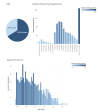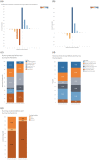Running behaviors, motivations, and injury risk during the COVID-19 pandemic: A survey of 1147 runners
- PMID: 33577584
- PMCID: PMC7880469
- DOI: 10.1371/journal.pone.0246300
Running behaviors, motivations, and injury risk during the COVID-19 pandemic: A survey of 1147 runners
Abstract
The COVID-19 pandemic has influenced activity behaviors worldwide. Given the accessibility of running as exercise, gaining information on running behaviors, motivations, and running-related injury (RRI) risk during the pandemic is warranted. The purpose of this study was to assess the influence of the COVID-19 pandemic on running volume, behaviors, motives, and RRI changes from the year prior to the pandemic to the timeframe during social isolation restrictions. Runners of all abilities were recruited via social media to complete a custom Qualtrics survey. Demographics, running volume, behaviors, motivations, and injury status were assessed for the year prior to the pandemic, and during social isolation measures. Descriptive statistics and Student's t-tests were used to assess changes in running outcomes during the pandemic. Logistic regressions were used to assess the influence of demographics on running behaviors and injury. Adjusted RRI risk ratios were calculated to determine the odds of sustaining an injury during the pandemic. Alpha was set to.05 for all analyses. A total of 1147 runners (66% females, median age: 35 years) across 15 countries (96% United States) completed the survey. Runners reported increased runs per week (Mean Difference with Standard Error [MD]: 0.30 [0.05], p < .001), sustained runs (MD: 0.44 [0.05], p < .001), mileage (MD: 0.87 [0.33], p = .01), and running times of day (MD: 0.11 [0.03], p < .001) during the pandemic, yet reported less workouts (i.e. sprint intervals; MD: -0.33 [0.06], p < .001), and less motives (MD [SE]: -0.41 [0.04], p < .001). Behavior changes were influenced by running experience and age. There was 1.40 (CI: 1.18,1.61) times the RRI risk during the pandemic compared to prior to the social isolation period. The COVID-19 pandemic influenced runners' behaviors with increased training volume, decreased intensity and motivation, and heightened injury risk. These results provide insights into how physical activity patterns were influenced by large-scale social isolation directives associated with the pandemic.
Conflict of interest statement
The authors have declared that no competing interests exist.
Figures



References
-
- Andersen JJ. The State of Running 2019. International Association of Athletics Federations; 2020 Mar. https://runrepeat.com/state-of-running
-
- Ghorbani F, Heidarimoghadam R, Karami M, Fathi K, Minasian V, Bahram ME. The Effect of Six-Week Aerobic Training Program on Cardiovascular Fitness, Body Composition and Mental Health among Female Students. Journal of Research in Health Sciences. 2014;14: 264–267. - PubMed
-
- Pucci GCMF, Rech CR, Fermino RC, Reis RS. Association between physical activity and quality of life in adults. Rev Saude Publica. 2012;46: 1–12. - PubMed
MeSH terms
LinkOut - more resources
Full Text Sources
Other Literature Sources
Medical

